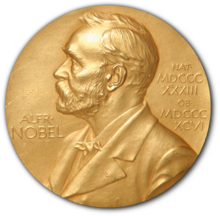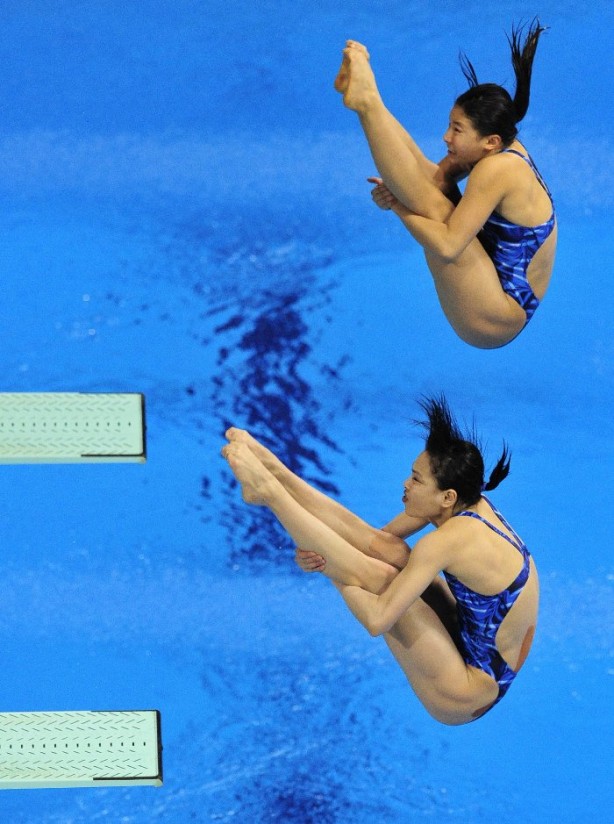 |
| The Nobel Prize |
Awards are, in their simplest forms, acknowledgments of an
achievement. Meritocratic societies
judge members of the collective on certain skills that are deemed important to
the group. As a global society, we have
decided that the areas of Physics, Chemistry, Literature, Peace, Economics, and
Medicine to be of highest importance.
Thus, those who demonstrate incredible skill, talent, dedication, and
proven results in these categories receive illustrious awards known as Nobel
Prizes, distinguishing them from all others who participate in the marketplace
of ideas and more specifically, in the fields mentioned above.
Sports, like Physics, Chemistry, Medicine, Literature, and
the rest, cannot be described as anything other than meritocratic. In every
game a winner emerges and a loser lives to play another day, but no matter what
the results, one team or player always rises above the rest, claiming the
title, “the best.” Because sports often
involve both team and individual activities, we recognize the feats of both
groups. Team awards are commonly seen as
more glorious, thus these awards are the pinnacles of team sports. In Baseball the team that wins the World
Series remains champions for a full season, an honor in itself. The team wins the most prestigious trophy,
and of course, the recognition from everyone associated with the sport.
 |
| The Cy Young Award |
Although team awards constitute the greatest of all accomplishments,
individual awards also matter a great deal.
These awards consist of the Most Valuable Player Award, the Cy Young
Award, Golden Gloves, Silver Sluggers, and All-Star game appearances. Each accolade comes with it’s own set of
idiosyncrasies, but I want to focus on the Cy Young Award.
First given out in in 1956, one year after the death of the
award’s namesake, Cy Young. Originally
the award was given to the best pitcher in the Major Leagues, but after 1967,
Major League Baseball decided to choose a winner in each league, one for the
National League and one in the American League. The Baseball Writers Association of America
votes on the winner of the award. The
winner is dubbed the “Baseball’s best regular season pitcher.” Obviously, this implies that any pitching
performed in the playoffs is not considered when choosing the Cy Young Award
winners.
Recently, I have
heard and read speculation that this years National League recipient of this
illustrious award should be one of two relief pitchers. Aroldis Chapman of the Cincinnati Reds and
Craig Kimbrel of the Atlanta Braves. Both
pitchers are relief pitchers, specifically known as closers. Their job is to come in the game in the 9th
inning when their team has a lead, but no more than a 4-run lead, and get the
final three outs to ensure a win.
Although my opinion of the whole structure of the modern bullpen is
biased towards getting rid of the entire construct, I still believe that
considering bullpen pitchers for the Cy Young Award to be ludicrous.
Closers compile a statistic that no other player does, due
to the situation in the game in which they play, known as the save. The full definition of what constitutes a
save can be found here: “The
Save” Saves do not mean very much when appraising a pitcher, due to the variability
with which a pitcher can attain a save.
Oftentimes closers will pitch in the most high-pressure situations. Imagine this.
Your team clings to a modest 2-run lead against your arch nemesis. The game has been grueling, with both teams
putting forth great amounts of effort.
The 9th and final inning comes about and with your team in
the lead you bring in your best relief pitcher to get the final three
outs. He comes into the game and must
face the opposing team’s three most ferocious hitters, batters who strike fear
in the average pitcher, and players who have already displayed their hitting
prowess by belting numerous hits throughout the game.
I don’t know about you, but that seems like a
pressured-filled situation to me. I
would want a pitcher in the game who could get three outs without allowing a
batter to reach first base safely, let alone put the ball in play. Pitchers who can rack up the strikeouts are
often closers, and thus pitch in these situations.
 |
| Kimbrel |
 |
| Chapman |
Now, here is a different situation. Your team is playing the last place team in
the league. You have a 3-run lead going
into the 9th inning, and scheduled to hit are the 7-8-9 hitters for
the opposing team. These three batters
barely produce any positive results no matter who stands opposite them on the
pitching mound. This situation lacks the
depth and tension that coursed throughout the 1st scenario. A pitcher who ends the game in this situation
receives a save equivalent to the one received if he finishes the first
game.
Saves are not good evaluators of value or even
effectiveness. They show that a pitcher
is able to thrive given very specific conditions, but does not distinguish
between the numerous other variables that can have a great effect on the
impressiveness of the situation.
So, Saves aren’t as amazing as pundits and coaches often
think. Surely other statistics exist
that can prove that relief pitchers are worthy of the Cy Young Award. The issue with every other statistic is that
the Baseball Writer’s Association evaluates starting pitchers on the same
statistics. The major difference between
starters and relievers is innings pitched.
I think that we, as fans and observers, can agree that given a larger
sample size we can draw more definitive conclusions. Innings pitched constitute the sample size
for a pitcher. If starters have more
innings pitched, than we have a clearer picture into their true value and thus
can better determine who is the “best pitcher in baseball.”
Here are some statistics of crucial statistical categories
used to analyze a pitcher’s performance:
|
Saves
|
ERA
|
WHIP
|
K/9
|
Chapman
|
28
|
1.26
|
0.68
|
16.74
|
Kimbrel
|
31
|
1.26
|
0.65
|
15.7
|
|
SO/BB
|
FIP
|
fWAR
|
Innings Pitched
|
Chapman
|
7.57
|
1.01
|
3.2
|
57
|
Kimbrel
|
6.82
|
0.98
|
2.3
|
43
|
|
Wins
|
ERA
|
WHIP
|
K/9
|
Cueto
|
15
|
2.72
|
1.16
|
9.2
|
Dickey
|
15
|
2.45
|
1
|
7.07
|
Gonzalez
|
14
|
3.32
|
1.14
|
9.83
|
|
SO/BB
|
FIP
|
fWAR
|
Innings Pitched
|
Cueto
|
3.43
|
2.88
|
4.1
|
162.1
|
Dickey
|
4.61
|
3.04
|
4.1
|
161.2
|
Gonzalez
|
2.85
|
2.7
|
4.1
|
141
|
In the second of the two charts I utilized the statistics of
the three top starting pitchers in the National League, Johnny Cueto of the
Reds, R.A. Dickey of the Mets, and Gio Gonzalez of the Nationals. I highlighted some particularly important
statistics in red. As you can see, all three starting pitchers’
innings pitched (our sample size) dwarf those of their relief
counterparts. Chapman and Kimbrel
obviously thrive at their jobs. With K/9
rates both higher than 15.00, these two relievers barely allow the ball to be
put in play. Even more so, they do not allow many base runners, as their WHIPS
perfectly indicate.
When calculating the statistic Wins Above Replacement,
innings pitched plays a vital role. The
stat is a value statistic, thus it encompasses many of the crucial aspects of,
in this case, pitching. On www.fangraphs.com, the site from which I
took this data, Chapman and Kimbrel do not even qualify for the category of WAR
unless you remove the restriction of a specific number of innings pitched. Even so, all three starting pitchers
mentioned, have higher WARs than Chapman and Kimbrel.
The idea of considering these two closers for the Cy Young
award should be discarded as soon as possible.
The two major reasons given when considering these two pitchers for the
award are that no other starting pitcher is having an outstanding enough year
to distance themselves from other pitchers, and that both Chapman and Kimbrel
are having historic seasons. I can’t
deny these are not true, but I can tell you that they do not and should not
matter when discussing who should win the award for best pitcher.
Just because the decision on who wins this award will be
difficult, does not imply that we need to start looking outside of the box for
an answer. Trust me, this is way outside
of the box. Oh, relievers have won the
Cy Young in the past, but very few of them actually deserved it. If you read the article I linked concerning
the rules governing a save, you might have noticed that a pitcher can attain a
save by pitching the last three innings of a game in which their team is
winning. The number of runs separating
the teams plays almost no significance other than that the pitcher’s team in
question must be winning the whole time.
Find me a relief pitcher who has accrued as many saves as Kimbrel and
Chapman, but did so by throwing three innings at least most of the time, and I
would consider them for the Cy Young Award.
www.baseball-reference.com,
calculates a pitcher’s performance in difference situations in a game. They dub a specific type of situation a high
leverage situation. In my opinion, even
a closer who pitches only in these high leverage situations but still throws a
third of the number of innings that a starting pitcher does remains undeserving
of the Cy Young Award. This has yet to
happen, and might make me think twice about just giving the award to a starter,
but in the end, it would not sway my opinion.
Innings pitched, a true sample size, constitutes too much importance.
 |
| The Great Mariano Rivera |
My attitude in this situation seems quite closed
minded. Under no circumstance, even a
clearly hypothetical one, will I consider a relief pitcher for the Cy
Young. That seems a bit unfair. Given that the modern bullpen schematic seems
fairly permanent, I think we should create a separate award for the best relief
pitcher in baseball. We can call it the
Mariano Rivera Award, named after the hands-down best relief pitcher ever to
take the mound. Rivera has never won a Cy Young Award.
This season I would give the Mariano Rivera Award to either
Aroldis Chapman or Craig Kimbrel. They
demonstrate incredible relief statistics and both deserve to be considered for
this hypothetical accolade. I don’t know
exactly who should win the Cy Young Award, but it should be a starting pitcher,
not a relief pitcher. Should we change
the award to mean the best starting pitcher in baseball? Yes, we should, and simultaneously
we should respect the specialization of the game and create the Mariano Rivera
Award.
In a true meritocracy, we shine a light on the best. In this case, we do not need to reconsider
who qualifies for a specific award as much as we should consider expanding the
entire awards process to include another prize.





